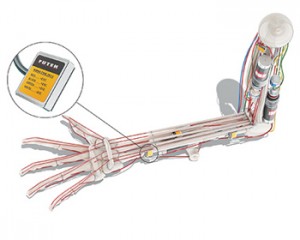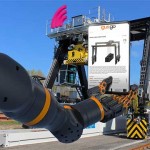Load cells verify forces in humanoid robotic arm
 The Robot Studio made a statement in the world of humanoid robotics when they aspired to replicate the form and function of arguably the most precise, versatile, and complex mechanical system to exist: the human forelimb consisting shoulder, arm, and hand. The mechanical structure was constructed to emulate the material properties and geometry of human bones, joints, and connective tissue with unprecedented detail and authenticity. Google supplied funds fueling the startup company Willow Garage to develop specialized control software, elegantly termed “ROS”. And Maxon motors were implemented to faithfully execute the orders of ROS.
The Robot Studio made a statement in the world of humanoid robotics when they aspired to replicate the form and function of arguably the most precise, versatile, and complex mechanical system to exist: the human forelimb consisting shoulder, arm, and hand. The mechanical structure was constructed to emulate the material properties and geometry of human bones, joints, and connective tissue with unprecedented detail and authenticity. Google supplied funds fueling the startup company Willow Garage to develop specialized control software, elegantly termed “ROS”. And Maxon motors were implemented to faithfully execute the orders of ROS.
But, for these refined feedback loops to breathe autonomy into the creation, they would need to be properly fed. The Robot Studio knew that, just like in the human body, the mechanical loads at play would need to be monitored with great sensitivity and quickness; they theorized this could be achieved by employing force sensor technology. But there were a couple caveats: these sensors would need to be designed to safely withstand incidental loads that exceeded the magnitude of forces they were designed to accurately monitor; and, to meet the spatial constrictions of this human form, their performance would need to be packaged into an impossibly small size.
Faced with a measurement challenge that fell somewhere between exotic and impossible, the Robot Studio reached out to FUTEK Advanced Sensor Technology. Since FUTEK had reputably pioneered sensor designs for applications ranging from deep sea to outer space, they expected the FUTEK engineering team would bring their own cutting-edge technologies to the table. They did not expect this futuristic sensor they sought would be in stock and ready for shipment: the LSB200 Super Miniature Load Sensor.
Out of the box, the overachieving performance specifications of the LSB200 more than fit the bill. An impressive 0.05% of scale nonlinearity comfortably can satisfy the most aggressive performance tolerances. A 1000% safe overload rating allows the LSB200 to survive forces up to ten times its calibrated range. And with all the precision and reliability of strain-based sensor technology packed into a geometric volume of roughly 2mL, the spatial displacement of the LSB200 seems more like a typographical error than reality. With the successful integration of the FUTEK LSB200 sensors, this groundbreaking prototype now serves as a platform for The Robot Studio’s next exploration: a biomimetic human torso.
In the ever-advancing field of robotics, the world can only guess what is next to come. And, we at FUTEK Advanced Sensor Technology await your call to help you get there.
Read more about the project on the FUTEK website.















